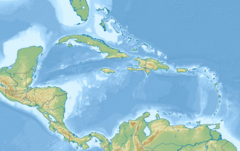Wallblake House
| Wallblake House | |
|---|---|
 |
|
|
Location within Anguilla
|
|
| General information | |
| Architectural style | Colonial architecture |
| Location | The Valley, Anguilla |
| Coordinates | 18°12′34″N 63°03′17″W / 18.209444°N 63.054722°W |
| Completed | 1787 |
Wallblake House is a heritage plantation house and museum annex in The Valley, Anguilla in the northeastern Caribbean. Built in 1787 by Will Blake, a sugar planter, it is stated to be the oldest structure on the island. Although gutted by the French in the late 1790s, it was rebuilt by the British and today has been fully restored, with its kitchen complex, stables and slave quarters intact. A church in the vicinity contains a stone fascia with open-air side walls and a ceiling, which is the form of a hull of a ship.
Wallblake House is one of the ten heritage houses in The Valley that was refurbished over a seven-year period and completed in 2004, at a cost of EC$250,000 (about US$92,000). The Wallblake Trust gained the support of the Catholic Church, many local enthusiasts and NGOS. The Heritage Trail Committee has raised the status of this house consequent to an agreement between the Wallblake Trust and the Anguilla Heritage Trail. It is Anguilla's only surviving plantation house.
The house was built in the mid to late 1700s. The name "Walblake" is probably a distortion of Valentine Blake, whose property in the Valley is mentioned in a deed from the 1690s. The construction date, 1787, is noted from an inscription on an old brick on the northern kitchen wing. The first historical event that occurred at the house was the French invasion by Victor Hugues of this island in 1796 when the Wallblake House witnessed a “crippled Anguillian” known as Hodge, taking shelter in its cellar. However, he could not escape the French soldiers who caught and executed him. This was followed by their gutting the property. The execution of the injured Anguillian further lead to a reparation reflex reaction by the Anguillians as they executed the French prisoners of war who had been detained in the Old Court House on Crocus Hill, without trial. However, the French were not successful in their invasion effort as the local Angullians put up a brave fight and were supported by the British ship, the HMS Lapwing, arriving on the scene at the right time. After this incident, the Wallblake estate was rebuilt. The house was owned by the planter Valentine Blake for some time.
In the 1800s, when Anguilla experienced severe drought, the estate resorted to raising economic crops such as sugar and cotton over an area of 97 acres (39 ha) of plantation, but with little success, the same being true with the other Anguillian plantations. Thereafter, the estate saw several owners. In the 1900s, it was with Carter Rey, a rich business baron who had bought the estate from the Lake family. Next, it was owned by his younger brother Frank Rey. In 1959, Marie Rey Lake, who had converted from the Anglican Church to being a Roman Catholic, donated the house to the Catholic Church, which continues to own it till this day. The house was leased to the Department of Tourism in 1978 for a time when they refurbished it. After the lease expired, the house was returned to the Roman Catholic Church and currently functions as a rectory.
...
Wikipedia


